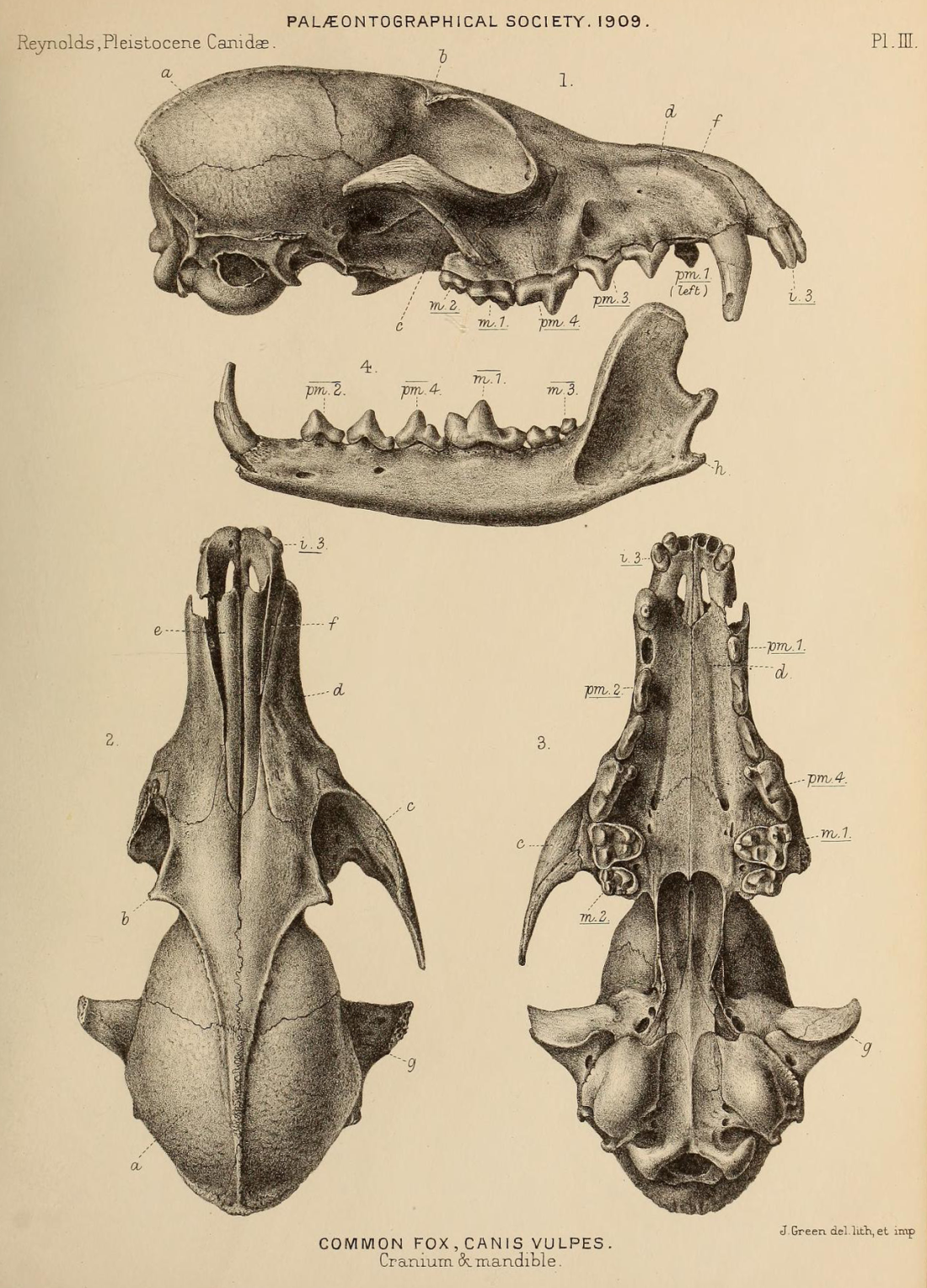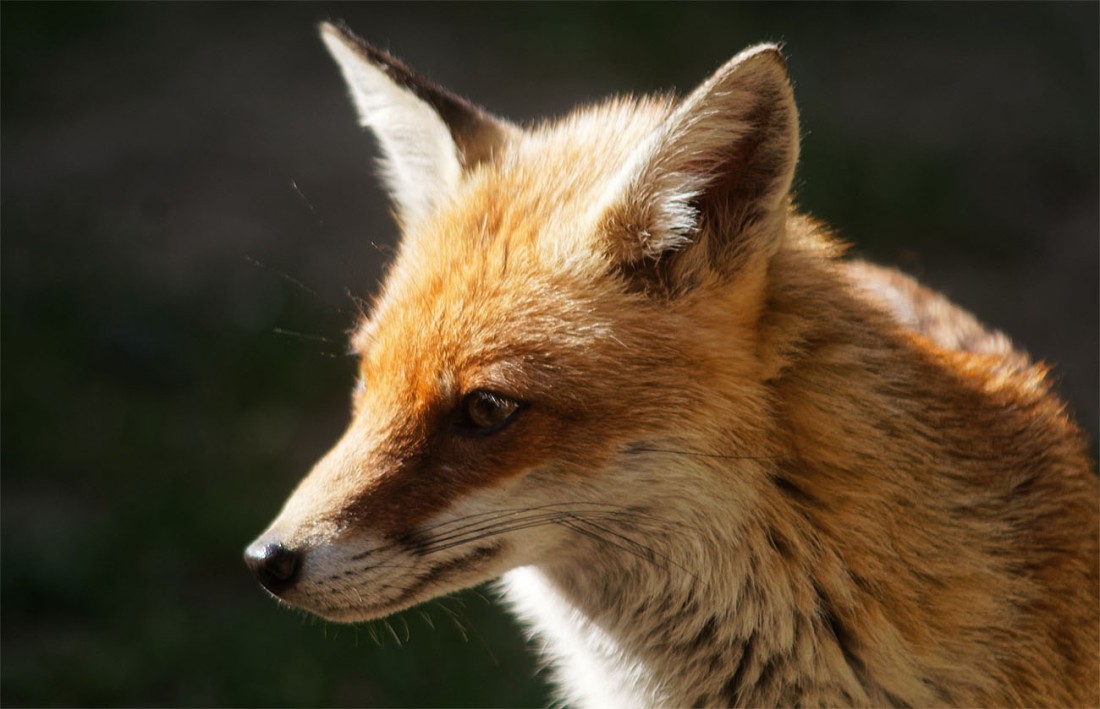Red fox, close to the North Downs, circa the late Pleistocene, aka the last ice age.

I happened across this drawing on Wikimedia last week, and was immediately struck by the curious thought that Edwardian scientists were drawing Pleistocene red fox bones not so many miles from where I now photograph those foxes’ probable descendants. This particular sketch dates from 1909 and is printed in A monograph of the British Pleistocene Mammalia, but the animal itself knew these hills many millennia ago.
What did it see on its daily travels? Its England was a kind that no living human has known. Spotted hyenas, straight-tusked elephants and cave lions roamed here, and foxes thrived alongside them all. They truly are a marvel of flexible pragmatism.
Today, of course, they live alongside us instead.

This vixen is known as ‘Pretty Face’. She has raised cubs this year, although she has not brought them to the garden. Her daily wanderings involve navigating cars, fences, and potentially dangerous introduced species such as pet cats. Like her ancestors, she survives.

And so does our ‘other’ fox, the glorious fox-and-cubs Pilosella aurantiaca.

And yet, like the conventional fox, it speaks of a hidden story. While flesh-and-blood foxes came to what is now England under their own steam – we were still a peninsula attached to continental Europe at the time – the flower arrived with help. It was brought here by people almost 400 years ago, when the unfortunate Charles I was on the throne. It was thought to be a cure for poor eyesight, but soon escaped into the countryside and has brightened up roadsides ever since.
I wonder if the first gardener who planted it realised that it would long outlast the king.
I don’t know this flower, but it’s very pretty.
LikeLiked by 1 person
It’s a member of the daisy family. I think it was originally native to the Alps.
LikeLiked by 1 person
Very nice. I’d love to have them in my garden.
LikeLiked by 1 person
A superb account Adele. Well done xxx
________________________________
LikeLiked by 1 person
Thanks Mum xxx
LikeLike
Adele, you haven’t had Pretty Face up for awhile! It’s nice to see her again!
LikeLiked by 1 person
Yes, I haven’t photographed the foxes much lately but they’re still here! 🙂
LikeLike
We have those red/orange flowers, too. I assume brought by the colonists. We called them Indian Paintbrushes as kids, which is also a common name of another Western flower as well. I like ‘Fox and Cubs’ better. Apparently, they are in decline here, probably due to lawn chemicals. What a scourge herbicide is.
LikeLiked by 1 person
Indeed it is. I am growing very weary of all the ways in which people are unkind to wild things.
Interesting that it is known as Indian paintbrush in your area. I have seen the other Indian paintbrush in the Rockies. It’s beautiful.
LikeLiked by 1 person
Interesting post Adele and excellent photos.
LikeLiked by 1 person
Thanks Belinda 🙂
LikeLiked by 1 person
Interesting history of foxes! 🙂
LikeLiked by 1 person
They have so many stories! 🙂 I didn’t include it in this post, but earlier in the year I visited the Peak District and saw an Arctic fox jawbone that had been recovered from a nearby cave. They’ve been extinct in Britain for several thousand years now but it is intriguing to imagine them trotting through a much frostier version of the North Downs.
LikeLike
Lovely post and images Adele. I sometimes think if I could just snap my fingers and go back in time to see what the world was like many, many years ago it would be quite fascinating. We are but a drop in the ocean, cosmically speaking, that is 🙂
LikeLiked by 1 person
Oh, I wish time machines existed! 🙂 To stand in a primeval English woodland and listen to the calls of the creatures that lived here when it was still a truly wild place – amazing. It’s quite surreal to think that lions once roamed here.
LikeLiked by 1 person
Oh … yes! I am good for that! 🙂
LikeLiked by 1 person
In addition to the extremely slow natural changes (such as continental drift) humans have been incredible shapers and changers of this planet. With industrialization our hugely extended capacity to impact rapidly the planet and all its life systems is alarming. Anyway, thanks for the tantalizing thoughts about how Britain was in such a distant epoch.
LikeLiked by 1 person
Yes, and agriculture remains the single biggest way in which we are changing things. Ironically, as we become ever more aware of our human footprint, there seems less and less concern about making it lighter. And some of the damage is so pointless. Yesterday, my local golf course used a mechanical flail on an ancient hedgerow because they thought ‘it had got out of hand’. They have devastated its wildlife value and probably killed protected species, and quite possibly committed a criminal offence, and for what? Just making a wild landscape look a bit more ‘tidy’?
LikeLiked by 1 person
When it is pointless it is even more crazy. And that fact that we should know better makes it crazier still. I am very sorry about the destruction on the hedgerow – that kind of wanton destructiveness can be so daunting.
LikeLiked by 1 person